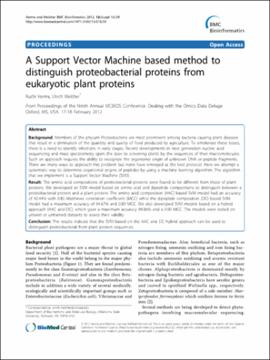| dc.contributor.author | Verma, Ruchi | |
| dc.contributor.author | Melcher, Ulrich | |
| dc.date.accessioned | 2018-11-09T21:10:58Z | |
| dc.date.available | 2018-11-09T21:10:58Z | |
| dc.date.issued | 2012-09-11 | |
| dc.identifier | oksd_verma_asupportvectorm_2012 | |
| dc.identifier.citation | Verma, R., & Melcher, U. (2012). A Support Vector Machine based method to distinguish proteobacterial proteins from eukaryotic plant proteins. BMC Bioinformatics, 13(Suppl 15), Article 59. https://doi.org/10.1186/1471-2105-13-S15-S9 | |
| dc.identifier.uri | https://hdl.handle.net/11244/302078 | |
| dc.description.abstract | Background: Members of the phylum Proteobacteria are most prominent among bacteria causing plant diseases that result in a diminution of the quantity and quality of food produced by agriculture. To ameliorate these losses, there is a need to identify infections in early stages. Recent developments in next generation nucleic acid sequencing and mass spectrometry open the door to screening plants by the sequences of their macromolecules. Such an approach requires the ability to recognize the organismal origin of unknown DNA or peptide fragments. There are many ways to approach this problem but none have emerged as the best protocol. Here we attempt a systematic way to determine organismal origins of peptides by using a machine learning algorithm. The algorithm that we implement is a Support Vector Machine (SVM). | |
| dc.description.abstract | Result: The amino acid compositions of proteobacterial proteins were found to be different from those of plant proteins. We developed an SVM model based on amino acid and dipeptide compositions to distinguish between a proteobacterial protein and a plant protein. The amino acid composition (AAC) based SVM model had an accuracy of 92.44% with 0.85 Matthews correlation coefficient (MCC) while the dipeptide composition (DC) based SVM model had a maximum accuracy of 94.67% and 0.89 MCC. We also developed SVM models based on a hybrid approach (AAC and DC), which gave a maximum accuracy 94.86% and a 0.90 MCC. The models were tested on unseen or untrained datasets to assess their validity. | |
| dc.description.abstract | Conclusion: The results indicate that the SVM based on the AAC and DC hybrid approach can be used to distinguish proteobacterial from plant protein sequences. | |
| dc.format | application/pdf | |
| dc.language | en_US | |
| dc.publisher | BioMed Central | |
| dc.rights | This material has been previously published. In the Oklahoma State University Library's institutional repository this version is made available through the open access principles and the terms of agreement/consent between the author(s) and the publisher. The permission policy on the use, reproduction or distribution of the material falls under fair use for educational, scholarship, and research purposes. Contact Digital Resources and Discovery Services at lib-dls@okstate.edu or 405-744-9161 for further information. | |
| dc.title | Support Vector Machine based method to distinguish proteobacterial proteins from eukaryotic plant proteins | |
| osu.filename | oksd_verma_asupportvectorm_2012.pdf | |
| dc.description.peerreview | Peer reviewed | |
| dc.identifier.doi | 10.1186/1471-2105-13-S15-S9 | |
| dc.description.department | Biochemistry and Molecular Biology | |
| dc.type.genre | Article | |
| dc.type.material | Text | |
| dc.subject.keywords | proteobacteria | |
| dc.subject.keywords | plant proteins | |
| dc.subject.keywords | svm | |
| dc.subject.keywords | machine learning | |
| dc.subject.keywords | amino acid composition | |
| dc.subject.keywords | dipeptide composition | |
